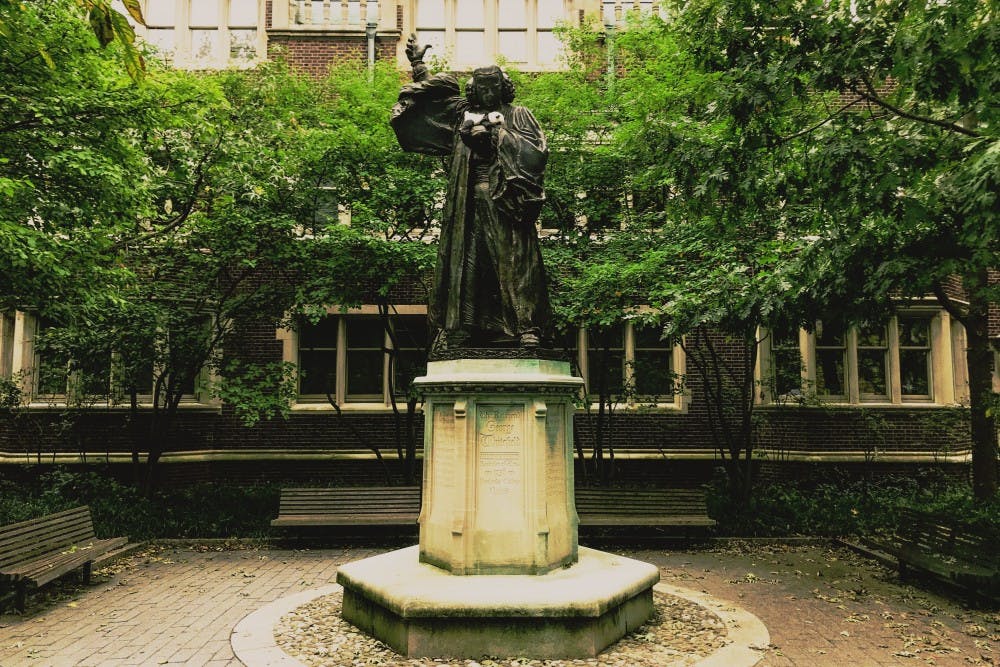
“Muy bonita” were the two most common words used by students to describe our campus recently in my Spanish class. I, too, used those words to describe our campus. Our professor praised us in agreement. There is no shortage of enchantment within the Penn community. On any normal day, Penn is a place to explore, learn, appreciate art, and share tickles with your friends through both words and affection. It’s amazing, some days there are goats to embrace, food to indulge in, but most importantly, it is a place where all of us are investing in our dreams. Goal chasing. Getting it. You could pick a student at random on Locust Walk and chances are, they would share something fascinating with you. The optimist in me would love to keep going with the positives but that’s not the direction of these words.
A false narrative has been dwelling on campus for the last one hundred years in the statue of George Whitefield. You know, that extremely theatrical and elaborate statue over in the Quad? Yeah, that statue that many of us have unknowingly passed on more occasions than we can count. It is a piece of public art that represents a man who was a racist enslaver. Now, I know those words have impact, but they are words that are in dire need of acknowledgement. When I first learned about Mr. Whitefield’s past, I was surprised. I mean, maybe I shouldn’t have been, and maybe my naivety with the history of this nation runs rampant. Yet, coming to terms with the fact that there is a statue on Penn’s campus of a man that actively engaged in promoting and campaigning for slavery to be permitted is hurtful and problematic on more levels than I was able to immediately comprehend. Mr. Whitefield’s statue represents a tortuous man that concluded wealth was more important than the lives of people of color. It needs to reflect that.
In an effort to get to the nitty gritty of Penn’s history with the institution of slavery, the Penn Slavery Project has been conducting archival research into Penn’s prior relationship with slavery since 2017. History Ph.D. candidate, VanJessica Gladney, focused some of her research for the Penn Slavery Project on Mr. Whitefield. While doing so, she unearthed concrete evidence of Mr. Whitefield’s progression from a minster that condemned the inhumane nature of the slave trade to a man that rallied for the opportunity to enslave and exploit human beings for personal gain. Mr. Whitefield intentionally and actively benefited from the narrative that blacks were inferior beings meant for enslavement.
As numbing as the reality of Mr. Whitefield’s past is, there is something else looming in the background, the function of public art. Public art meant is to educate. In most instances, art figures are used as a point of attraction that leads to enlightenment. If public art is supposed to foster knowledge, what do we do when it fails at telling the truth? Now that I know the truth about who Mr. Whitefield was, am I supposed to turn a cheek and ignore the effect he had on thousands and thousands of people of color?
I can’t and I won’t. Mr. Whitefield’s activism, support and participation in slavery is something that must be known.
After discussing Mr. Whitefield recently with VanJessica Gladney, some of the key words I took from our conversation regarding Mr. Whitefield’s statue from her were “when you look at this [statue], you learn and it gives the semblance of having told the whole story, and I think that as an academic institution, we have a responsibility to do our best to show the whole story.” With that being said, should Mr. Whitefield’s statue be taken down immediately? Would that transform his history? Our history? No, no, and no. You can’t disregard the complicated parts of history that don’t fit, like wrongly cut puzzle pieces.
There has to be an acknowledgment of the whole truth. Mr. Whitefield’s statue should stay where it has been for the last one hundred years but the available information about him located near his statue should reflect his entire truth. If a search engine can lead to a stream of significance regarding who Mr. Whitefield truly was, we, as a community, should respect ourselves enough to tell the truth, too.

JESSICA GOODING is a College junior from Philadelphia, Pennsylvania studying History and English. Her email address is jgooding@sas.upenn.edu.
The Daily Pennsylvanian is an independent, student-run newspaper. Please consider making a donation to support the coverage that shapes the University. Your generosity ensures a future of strong journalism at Penn.
Donate







